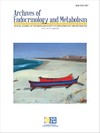
Arch Endocrinol Metab. 2018 Aug;62(4):431-437. doi: 10.20945/2359-3997000000059.
Lean mass as a determinant of bone mineral density of proximal femur in postmenopausal women
Marin-Mio RV1, Moreira LDF1, Camargo M1, Périgo NAS2, Cerondoglo MS2, Lazaretti-Castro M1.
Author information:
1. Disciplina de Endocrinologia da Universidade Federal de São Paulo (Unifesp), São Paulo, SP Brasil.
2. Disciplina de Geriatria e Gerontologia da Universidade Federal de São Paulo (Unifesp), São Paulo, SP, Brasil.
Abstract
OBJECTIVE:
To verify which component of body composition (BC) has greater influence on postmenopausal women bone mineral density (BMD).
SUBJECTS AND METHODS:
Four hundred and thirty women undergoing treatment for osteoporosis and 513 untreated women, except for calcium and vitamin D. Multiple linear regression analysis was performed in order to correlated BMD at lumbar spine (LS), total femur (FT), femoral neck (FN) with body mass (BM), total lean mass (LM) and total fat mass (FM), all determined by DXA.
RESULTS:
BM significantly correlated with all bone sites in untreated and treated women (r = 0.420 vs 0.277 at LS; r = 0.490 vs 0.418 at FN, r = 0.496 vs 0.414 at FT, respectively). In untreated women, the LM correlated better than FM with all sites, explaining 179% of LS; 32.3% of FN and 30.2% of FT; whereas FM explained 13.2% of LS; 277% of FN, 23.4% of FT In treated women, correlations with BC were less relevant, with the LM explaining 6.7% of BMD at LS; 15.2% of FN, 16% of FT, whereas the FM explained 8.1% of LS; 179% of FN and 176% of FT.
CONCLUSION:
LM in untreated women was better predictor of BMD than FM, especialy for distal femur, where it explained more than 30% of the BMD, suggesting that maintaining a healthy muscle mass may contribute to decrease osteoporosis risk. Treatment with anti-osteoporotic drugs seems to mask these relationships. Arch Endocrinol Metab. 2018;62(4):431-7.


